Dungeons and Dragons was first published 46 years ago and is still as popular as ever. However, getting started into this expansive roleplaying game can be tough, especially for children. If only there were a gateway game to introduce the main concepts of the game without lots of reading and math. Now with Dungeons and Dragons: Adventure Begins there is a way for beginners to get the feel of the game and decide if they want to delve deeper into the dungeon.
What Is Dungeons and Dragons: Adventure Begins?
Dungeons and Dragons: Adventure Begins is a game for 2-4 players, ages 10 and up, and takes about 60 to 90 minutes to play. It is available from Amazon and other retailers with a suggested price of $24.99. Dungeons and Dragons: Adventure Begins is published by Wizards of the Coast and Hasbro Gaming.
Dungeons and Dragons: Adventure Begins Components
- 4 mini-figures
- 4 20-sided hero dice
- 1 10-sided dungeon master die
- 4 boss tiles
- 1 boss stand
- 20 hero tiles (5 per character)
- 4 health trackers
- 1 plastic deck holder with damage clip
- 24 gold tokens
- 12 item cards
- 12 gatekeeper cards
- 8 backpack cards
- 4 reference cards
- 96 adventure cards, divided into 4 decks
- 4 dungeon boards
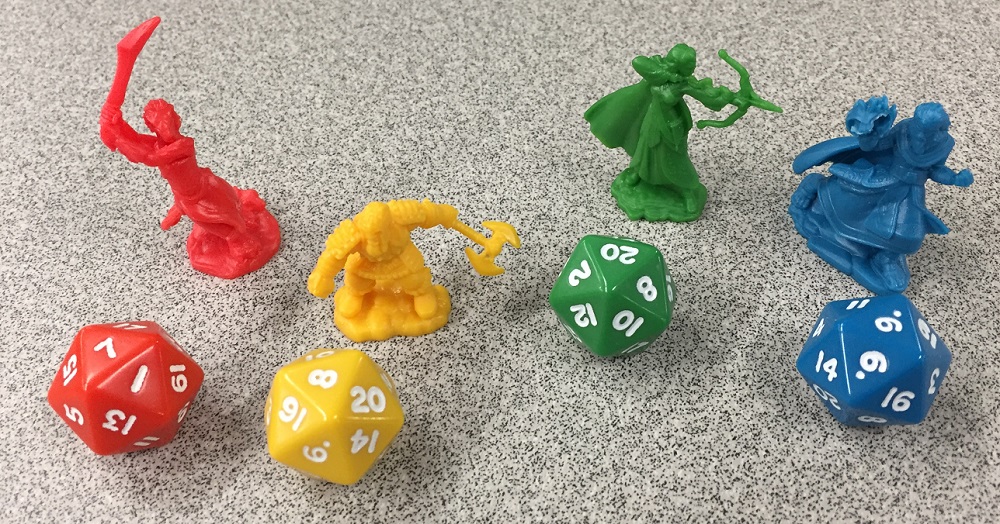
The four mini-figures represent the four playable character types in the game. Choose from an Elf Bard, a Dwarf Fighter, a Dragonborn Rogue, or a Human sorcerer. Each player also gets a 20-sided die that matches their character’s color.

Each player gets five double-sided hero tiles in their character’s color. The character tile lets you choose from two heroes and lists their race and class. The two personality tiles provides 4 different options listing attributes as well as a special ability which can be used once per dungeon board. There are two different combat tiles which list the different attacks the hero can make. There is a level one side and a level 2 side used after upgrading your hero. Each player begins with a backpack card listing items with which their hero begins that can serve as inspiration for how the hero responds to events during the game. Players can also purchase items during their quest that provide special abilities.
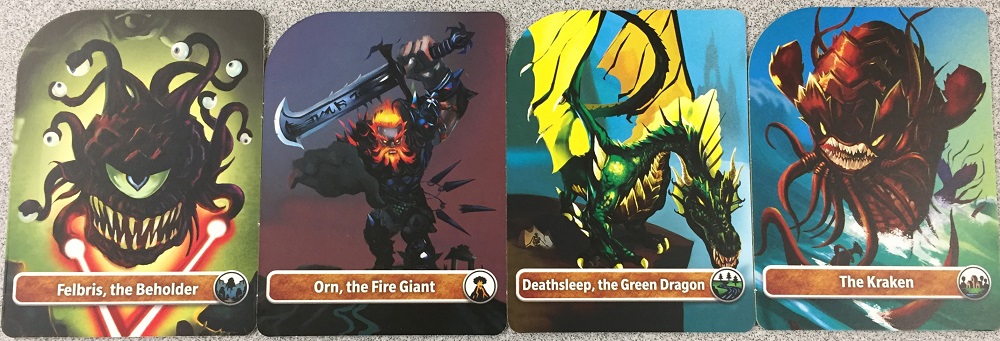
There are four different bosses represented by their Boss tiles. Choose from Felbris the Beholder, Orn the Fire Giant, Deathsleep the Green Dragon, or The Kraken. Three gatekeeps come along with each Boss as well as a unique storyline.

The deckholder is used by the dungeon master to store an adventure deck and display the current scenario card or monster card. Each dungeon tile has its own adventure deck and the damage clip is used on monster cards to keep track of its health.

The four dungeon boards connect to create the game board. Each Boss has their own dungeon board which is placed at the far end of the game board from where the heroes begin.
How to Play Dungeons and Dragons: Adventure Begins
The Goal
The goal of the game is to reach the last space on the last dungeon tile and defeat the Boss. While it is fairly straightforward, there is a lot of danger and adventure along the way.
Setup
The first step in setting up a game is to choose your journey. This involves selecting from one of the four Boss monsters. Place the Boss tile in the Boss stand and place it in the gatekeeper space on that Boss’s dungeon tile. Then connect the three remaining dungeon boards to create the game board. Select the Boss’s three gatekeeper cards and place them in order from 1 to 3 next to the gatekeeper spaces at the end of each dungeon board, beginning with the starting dungeon board. Select the adventure deck which matches the first dungeon board. Shuffle the deck and place it inside the deck holder. Place the 10-sided dungeon master die and the damage clip in the tray on top of the deck holder. Shuffle the deck of item cards and place it to the side of the game board along with a pile of gold tokens.
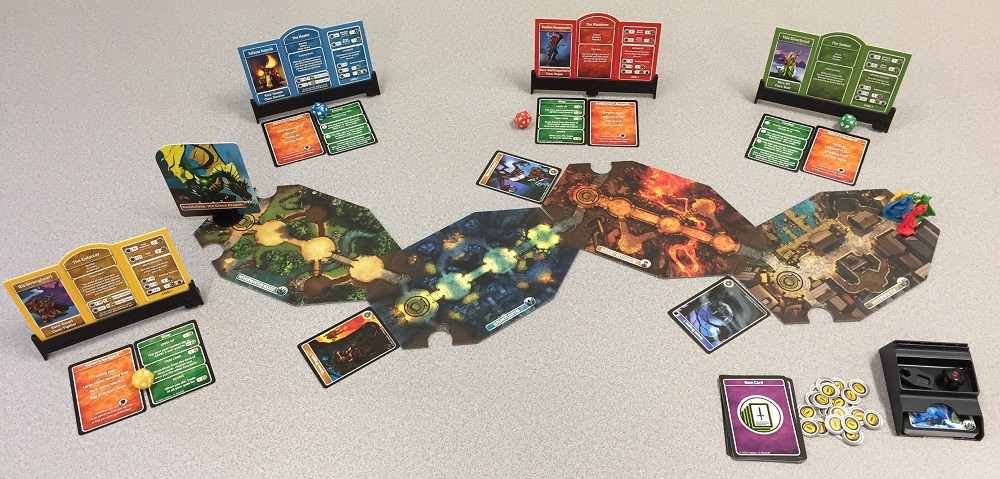
Now it is time for players to choose their heroes. After taking a health tracker and setting the health to 10, each player takes 5 hero tiles of matching color. Select one side of character tile in the left side of the health tracker, one of the two personality tiles in the center, and one of the two combat tiles on the right side with the Level 1 side facing the player. The hero tiles let players customize their character with different attributes, special abilities, and attacks. Players then take a mini-figure and a 20-sided hero die in their character’s color. Place the mini-figures in the first space of the first dungeon board. Finally, players select any backpack card that they want and place it next to their hero tracker. You are now ready to begin the adventure.
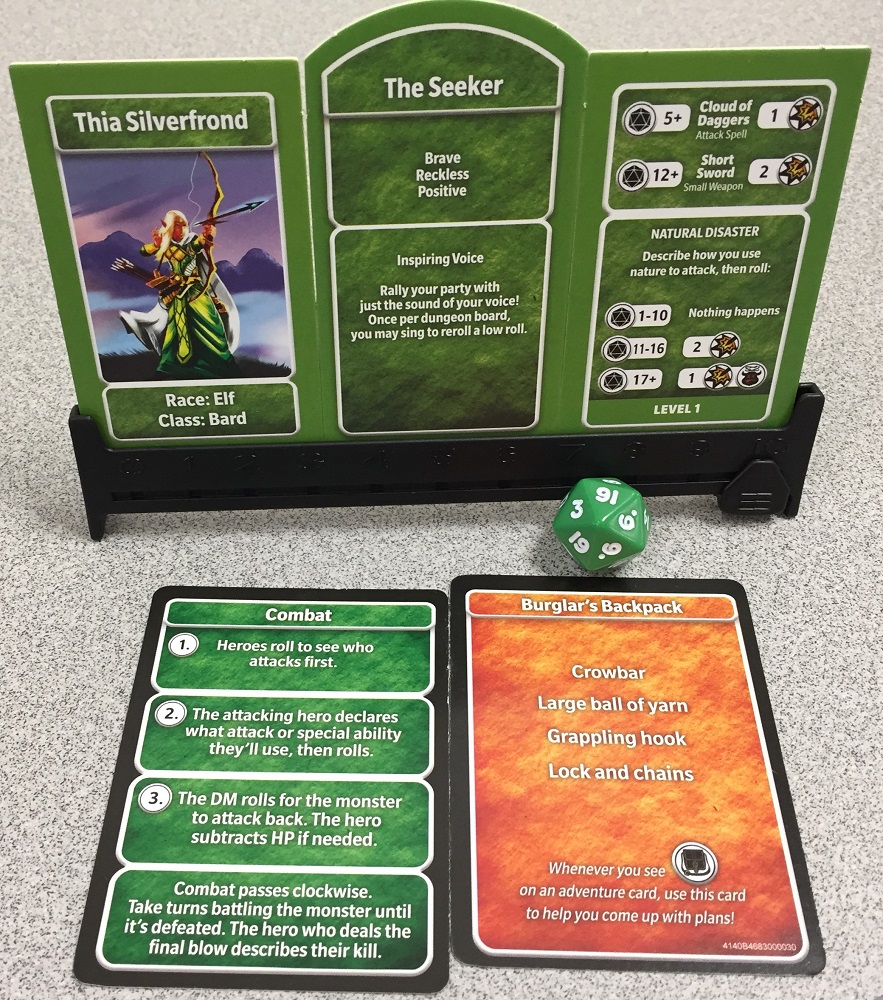
Gameplay
Dungeons and Dragons: Adventure Begins is played in turns. The oldest player starts with the deck holder and acts as the dungeon master (DM) for the first turn. They draw the first card from the adventure deck and place it in the stand of the deck holder with the text facing the DM. The DM reads the story text at the top of the card to the party. Cards can be either scenarios or monsters.

If the current adventure card is a scenario, all players, including the DM unless stated otherwise, follow the instructions in the call to action. If a die roll is required, the DM rolls the 10-sided DM die. Once the call to action has been completed, the DM then reads the outcome portion of the card and executes the results. The DM then discards the adventure card to bottom of the deck. On the other hand, if the adventure card is a monster, combat begins.

To begin combat, the damage clip is attached to the card with the window on the clip showing the highest health value of the monster. The artwork faces the other players and only the DM can read the text on the card. The DM also reads any strengths or weaknesses the monster may have. Players roll their hero dice to determine who attacks first. A hero can declare either an attack or use their special ability, which can only be used once per dungeon board. If attacking, the player selects one of their three attacks. Each attack lists a number which must be rolled or higher in order to be successful. To the right of the attack is the amount of damage a successful attack inflicts on the monster. Creative attacks can have different results depending on which number is rolled on the die. The DM lowers the damage clip on the monster card a number of health spaces equal to the damage inflicted. If a hero chooses their special ability, then follow the directions. The monster then gets to attack the player who just acted. The DM rolls the black DM die for the monster and tells the player how much damage is inflicted on them. Move the health tracker down that amount. Combat continues with the player to the left going next. After each hero attacks, the monster gets to attack back. Continue going around until the monster is defeated. The player who delivers the killing blow must describe how they defeated the monster. The DM then distributes and gold or items listed on the card as a reward to the players on that space.
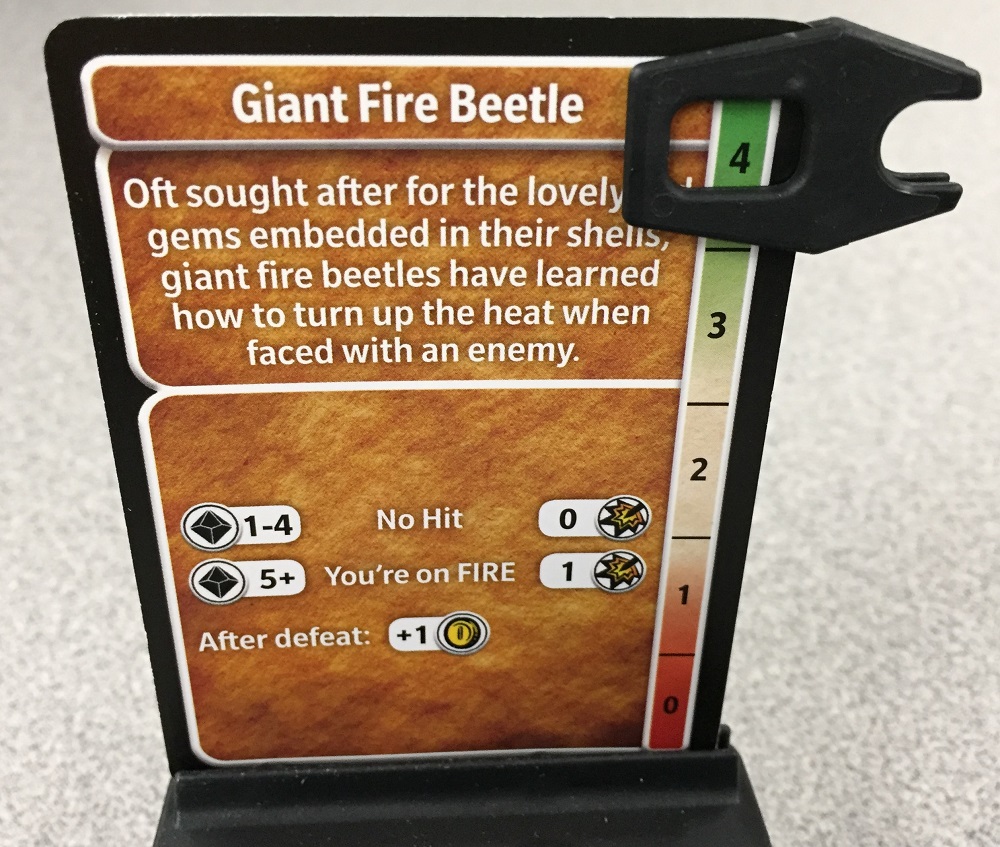
Each dungeon board consists of four core spaces in a line down the center of the board and two monster spaces off to the side. At the start of each turn, players decide individually if their hero will advance to the next core space or move off to a monster space. After the first turn, the DM passes the deck holder to the player to their left. That player is the DM for the next turn. This allows each player to take the role of DM during the game. If all players decided to advance to the next core space, the DM draws the next card from the adventure deck. However if some players chose to move to the monster space, the next monster card in the deck is selected and combat begins with only those players in the monster space involved. Once the monster has been defeated, the victories heroes join the rest of the party in the core space.
When players reach the gatekeeper space at the end of the current dungeon board, instead of drawing a new card, the DM selects the gatekeeper card next to the dungeon board and then the party either plays through the scenario or fights the monster to complete the dungeon board. The adventure deck is then removed from the deck holder and the deck for the next dungeon board is shuffled and placed in the deck holder.
During the course of the game, players earn rewards by completing scenarios and defeating monsters. Gold is often a reward and can be spent for two main purposes. For the cost of 3 gold a player can purchase an item. This can take place at any time except during combat. Return 3 gold to the pile and draw three cards from the item deck. The player keeps one and shuffle the other two back into the item deck. Items can only be used once per dungeon board and you can only play one item per attack or when you are attacked. Once used, flip the item card over to show that it has been exhausted. Players can also spend 5 gold to level up their character. Again, this can be done anytime except during combat. Flip the hero’s combat tile to the level 2 side and then reset the hero’s health back up to 10.
If your hero’s health points fall to 0, they are dead. Return all your gold to the pile to regain 5 health and continue to play. If you don’t have any gold, any other player can donate one piece of gold to save you. If you die during combat, you sit out for the remainder of the fight and do not receive any rewards for defeating the monster. Once combat is over, you can use gold to revive yourself.
Game End
Once you reach the last space on the last dungeon tile, you must face the Boss. The new DM takes the Boss tile and attaches the damage clip. Play continues as normal combat. After the Boss is defeated, the player who inflicted the last damage describes how they defeated the Boss and then reads the winning story text on the bottom of the Boss tile.
Why You Should Play Dungeons and Dragons: Adventure Begins
While one of my older sons enjoys playing Dungeons and Dragons with his friends, my two younger children have never experienced it but have shown some interest. When I learned of Dungeons and Dragons: Adventure Begins, I wanted to play it with them. In many role-playing games, it can take some time creating a character and getting organized before anyone even takes one step into a dungeon, let alone smells the sulfurous heat of a dragon. Dungeons and Dragons: Adventure Begins, setup is fairly quick. Character creation could not be easier. Players pick three of five hero tiles and everything they need to know about that character is ready to go. Pick a boss, connect the four dungeon boards, select the current adventure deck, and the game is ready to play.

I really like the way the dungeon master is handled in this game. Each player gets to be the DM since the role changes every turn. The adventure decks, each aligned with a dungeon board, provide everything the DM needs for the turn. The scenarios are interesting while being fun and even sometimes silly. For example, players may have to get up and do a dance of their race with the DM deciding which dance it best. These scenarios are designed with the age range of players in mind. They are quick and keep the players engaged. The monsters provide a greater challenge. Some are easy to defeat while others can be more difficult. I noticed that with 4 players, the monsters are easier to defeat since characters tend to take more damage in 2- or 3-player games. However, even if a character dies by losing all their life during a battle, they can be revived and continue the game after that battle. Also, players can choose to fight more monsters by moving through the monster spaces instead of staying on the core spaces. Staying on the core spaces also makes for a quicker game.

Dungeons and Dragons: Adventure Begins also has a lot of replayability. There are four different bosses each with their own three gatekeepers. Each adventure deck has 24 cards; however, in a single game, you will only use up to 5 of those cards and that is if you decide to visit both monster spaces. Furthermore, the game also gives players a taste of role-playing. Whenever they use their special attack, players must describe how they are attacking the monster. Some scenario cards require players to come up with a solution to a problem using the items in their backpack. I found my kids even describing their simple attacks as they got into the adventure.
The suggested age of 10 years and up is primarily based on reading ability. Younger children will still enjoy the game if they can read the text on their own or an older sibling or adult could help them read the text. Younger players may also want to skip being the DM until they become more familiar with the game mechanics.
Dungeons and Dragons: Adventure Begins definitely hits its target. It does a wonderful job of providing a fun and fast entry into the world of Dungeons and Dragons. Even though I have played D&D in the past, I still enjoyed playing this game with my children and they are now interested in expanding into the classic role-playing game. I highly recommend this game for families with children in this age range to give them a taste of D&D. Even if you don’t go any further into the series, Dungeons and Dragons: Adventure Begins is a fun game on its own.
If Dungeons and Dragons: Adventure Begins sounds like a game for you and your family, you can purchase it from Amazon.
Click here to see all our tabletop game reviews.
![]() To subscribe to GeekDad’s tabletop gaming coverage, please copy this link and add it to your RSS reader.
To subscribe to GeekDad’s tabletop gaming coverage, please copy this link and add it to your RSS reader.
Disclosure: GeekDad received a copy of this game for review purposes.




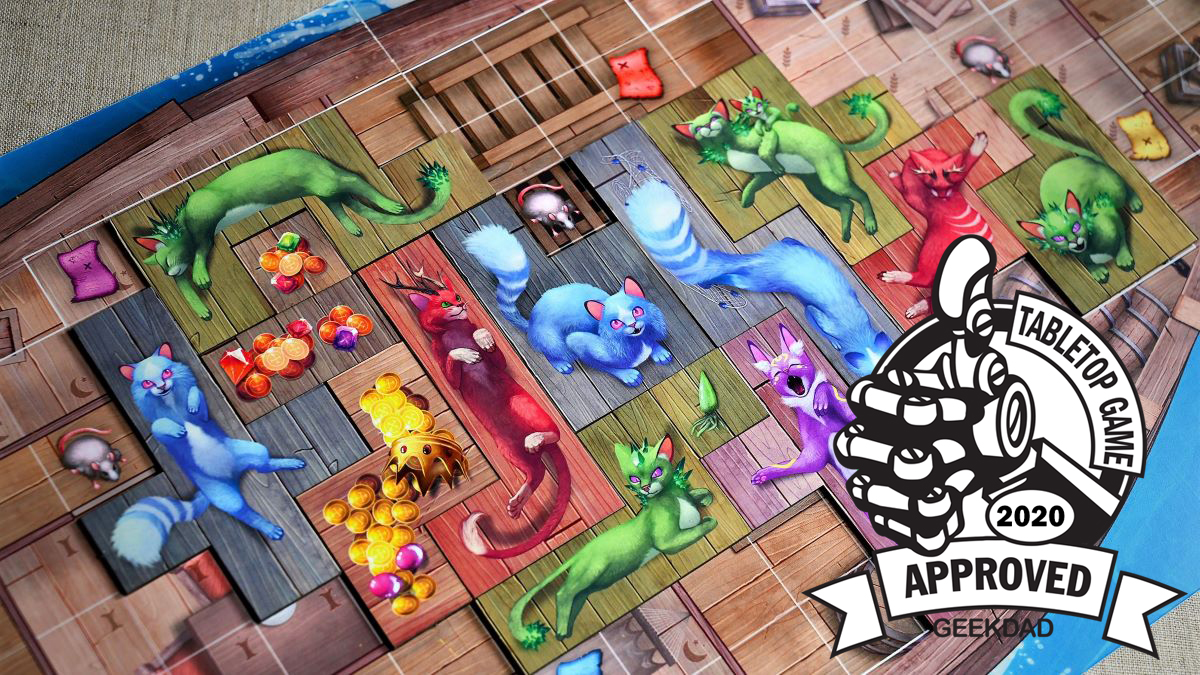
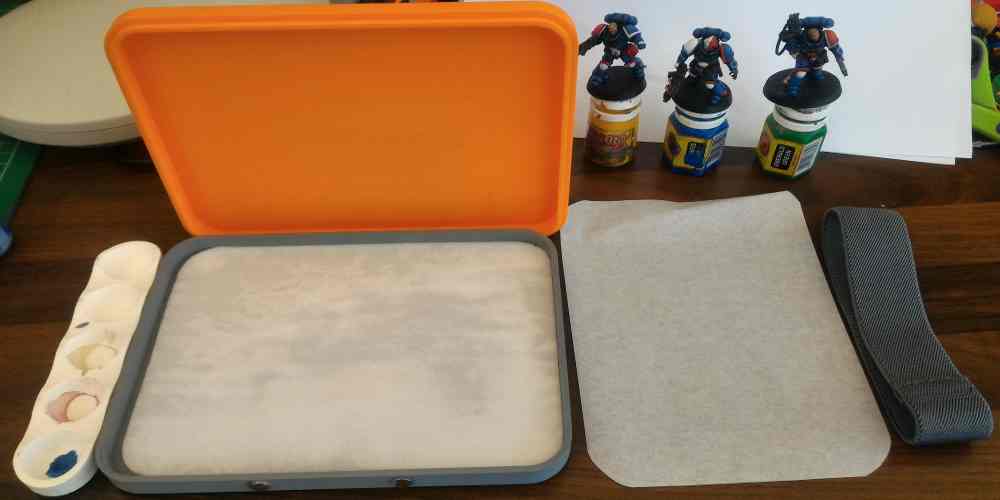
Thought they got banned after BML things
How do the characters change when the DM role changes hands? Does the new DM have the previous DM control his or her character? This would mean each player would experience control of two different characters, a good thing, but it might be confusing for some players. Adding a fifth character could be the solution, with the expectation that the current DM’s character acts as a pack animal each turn. This would add the need for a fifth play board and bad guy set of monsters. Also, if this starter set goes well, Hasbro of the Coast could sell add-on packs of additional characters, and adventures, to extend the playability of this game. This sounds like a good start.
That is a good question. Actually, the DM continues to play their own character. So in combat, they would roll for their character’s attack as well as for the monster. If there are five players. one player could remain the DM the entire game. While it sounds confusing, the system actually works quite well. The adventure cards have all the information for each scenario or monster. The DM is just reading and making dice rolls.